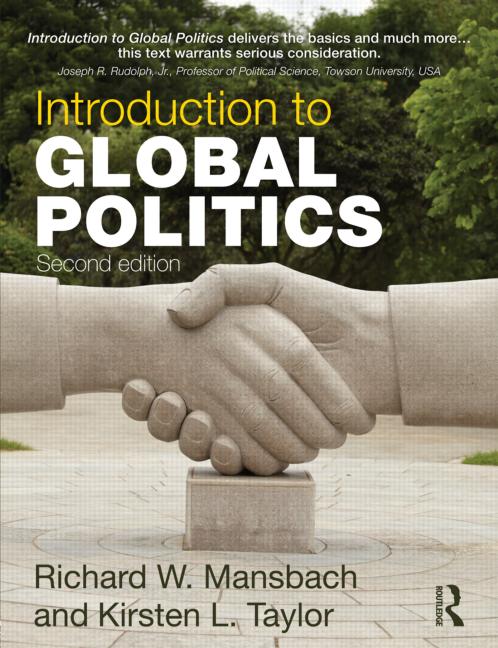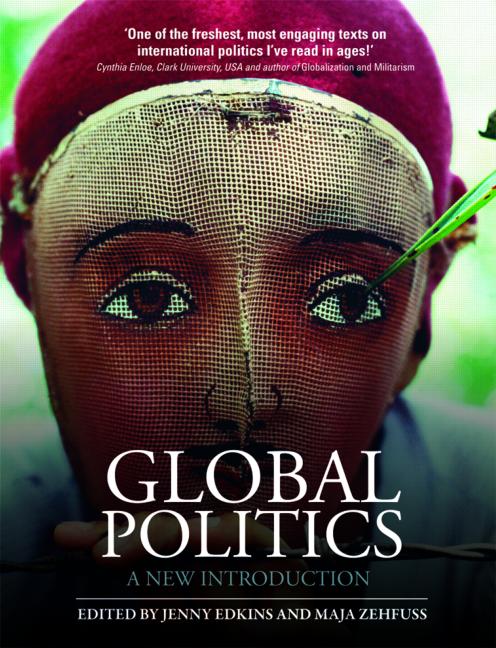Global political studies is a multi-faceted discipline encompassing international relations, foreign politics and domestic government policy. To new students, it can be bewildering. They are expected to analyse and explain complicated events, and are offered a correspondingly full and forbidding interdisciplinary toolkit to apply to the task. Introductory textbooks link the various components and allow beginners to view the discipline as a self-supporting whole. A good textbook is indispensible for students getting to grips with their chosen topic. Edkins and Zehfuss’s Global Politics: A New Introduction (hereafter GPNI) and Mansbach and Taylor’s Introduction to Global Politics (IGP) both seek to fill this important role.
 In IGP we are promised ‘an historical approach,’ as this is what ‘best allows students to understand continuity as well as change.’ The editors claim that by appreciating ‘the historical roots of the present,’ and linking ‘historical material with the contemporary and the abstract with the concrete,’ students will gain a rounded understanding of and critical purchase on the complexities of global politics.
In IGP we are promised ‘an historical approach,’ as this is what ‘best allows students to understand continuity as well as change.’ The editors claim that by appreciating ‘the historical roots of the present,’ and linking ‘historical material with the contemporary and the abstract with the concrete,’ students will gain a rounded understanding of and critical purchase on the complexities of global politics.
IGP’s scope is ambitious, and the editors’ intention to offer such a comprehensive introduction is laudable. Familiar historical examples offset and contextualise theoretical debates throughout, meaning that students can apply new ideas to events that they know about already. The drawback of this breadth is that at times the discussion seems scattershot and frustratingly shallow. At its worst this is straightforwardly misleading: we are given a précis of Thomas Hobbes’ Leviathan, for example, which suggests that his book was about states, rather than rationality, sovereignty and human nature, as is of course the case. It may be objected that this interpretation of Hobbes has an established place in (realist) international relations theory, and IGP’s author should not be criticised for reproducing that. But a new student of global politics is unlikely to know that this is merely an extension and interpretation of Hobbes’ actual arguments. They are given just enough material to understand the slimmed-down, discipline-specific version of Hobbes, but too little to be able to assess the value of that interpretation.
Similar problems recur throughout IGP. This book supplies a fairly mainstream American IR worldview without giving students reason to investigate the matter from different perspectives. IGP is adequate to give eager students a good grounding in the discipline’s basics and thus induct them into its idiosyncratic ways of thinking; but unless they are encouraged to think through and criticise its substantive content, they stand to inherit existing flaws along with the wealth of good material presented here.
 GPNI follows a different strategy, and begins with the claim that existing introductions ‘fall into two camps – either starting with various “theoretical approaches,” or introducing global politics as a series of “issues.”’ Respectively, these approaches are ‘well worn and somewhat formulaic’ and ‘frustrating’; so the editors propose to prioritise neither, and instead begin with ‘questions about how to conceptualise the world and [our] place within it.’
GPNI follows a different strategy, and begins with the claim that existing introductions ‘fall into two camps – either starting with various “theoretical approaches,” or introducing global politics as a series of “issues.”’ Respectively, these approaches are ‘well worn and somewhat formulaic’ and ‘frustrating’; so the editors propose to prioritise neither, and instead begin with ‘questions about how to conceptualise the world and [our] place within it.’
Each chapter follows a standard structure, beginning with a question highlighted by an example, then a set of responses and discussion points. The questions and examples are well chosen, reflecting real concerns that curious beginners (and experts) might have. To give just two examples: Annick T.R. Wibben asks, ‘Who do we think we are?’, leading to a discussion of group identity, with the American feminist movement serving as her case study. Jenny Edkins asks, ‘Why do we obey?’, leading to a discussion of civil disobedience and legitimate authority alongside the revolutions of 1989. These are big questions, for sure, but here the answers seem better grounded. The use of a narrower range of examples enables the authors to write authoritatively on their chosen topics. Rather than applying theory to many isolated incidents, students can watch the relevant questions and tentative answers arise organically amid the complexities of single cases more deeply considered.
The chief disadvantage of this approach is that some chapters begin to resemble articles. Clearly the authors have established positions on the topics they discuss. For example: Roxanne Lynn Doty’s chapter, which asks, ‘Why is people’s movement restricted?’ discusses undocumented migration from Mexico to the US. Doty offers a rich and interesting description of the case, which gives rise to important questions about the meaning of citizenship, nationhood and territory. The major ‘broader issue’ presented is ‘cultural racism.’ Doty has written about this issue in other works, and there is no doubt that it is worth discussing in this context. But the omission of other plausible objections is striking; there is a risk of carrying this introduction too near to a conclusion. When readers encounter these debates for the first time, they may be prone to take authors’ accounts as fully authoritative and the debates more completely settled (in favour of the author’s view) than is in fact the case. This reservation aside, this chapter, like those throughout GPNI, is well structured, clear, accessible, and while perhaps over-spiced with the author’s interpretation, it introduces its topic and brings it to life in a lucid and interesting way. The chapters have real continuity and clarity of purpose. They can – and deserve to – be read from start from finish, rather than picked for quotable lines and definitions in the way textbooks so often are.
All of this makes GPNI something more than a reference book. The greater depth and tighter focus means that authors can explain special controversies in a genuinely interesting way without becoming side-tracked by raw theory or reductive historical examples. The generous provision of asides in special boxes and marginal notes (which can direct readers to pertinent discussions in other chapters) helps to bring out the mutual relevance of the chapters, as case studies within the broader discipline of global political studies. The standard structure makes great intuitive sense. Students will be able to follow the discussion and navigate the text with ease. It is refreshing to see such an attempt to improve clarity and prompt further reading without resorting to crude oversimplification and jargon.
—
In both books the visual layout is generally clear. GPNI’s illustrations are presented in black-and-white, which causes some problems – maps and (most) diagrams are fine, but photographs are often murky and indistinct, and will appear doubly so when pages are photocopied for classroom use. IGP, by contrast, is attractively furnished with full-colour figures. While a banal point of difference, IGP’s colours are an asset: they make the book visually interesting and its figures easy to interpret. A clear map or a provocative photograph can be all that is needed to make a student read on rather than give up when her attention flags.
Both books are well supplied with extra features supporting the main text. IGP offers excerpts from ‘key documents,’ along with salient trivia and asides on ‘theory in the real world,’ tying together empirical and theoretical information. Likewise, GPNI includes highlighted boxes to introduce important ideas, people and concepts, as well as the useful marginal comments mentioned previously. In both books these help to break up the text with relevant but inessential information to deepen readers’ knowledge and link it to other parts of the discipline.
In summary: IGP’s ‘historical approach’ gives readers a strange and conspicuously artificial list of history’s big moments, as though these were definitive and final. One hopes that students will appreciate that they are reading a version of history designed and fitted to a certain interpretation of global politics. Nonetheless, IGP is not a bad textbook. It is substantial and attractive, and as mentioned, it covers, at an admittedly rapid pace, a wide range of material. Eager students will be able to draw from its pages a thin but broad base on which they can later build.
GPNI does not claim or try to offer a total overview like that of IGP. Nonetheless, it more than compensates for any loss in its careful planning and sensitive execution. In this respect, while GPNI’s aims are less ambitious, the book is a greater success. It is enjoyable to read; it subtly ties together the topic’s many strands and, with its provocative and well-chosen questions, it encourages further enquiry. While no textbook can hope to deliver its entire topic intact, GPNI does the next best thing: it equips readers with a set of questions and a whole armoury of ideas to use when devising answers. That, surely, is the mark of a successful textbook.
—
James Wakefield is a PhD candidate at Cardiff University, where he also teaches on a range of undergraduate modules. His main research interests are in political theory, and include the ethics of education, liberal perfectionism and the Italian philosopher Giovanni Gentile.
The books herein are selected by e-IR for inclusion in our student book features solely due to their value to students – as determined by our editorial team in counsel with selected teaching academics – and not as promotional advertising on behalf of the publisher(s), who kindly provide us with the above books so that we are able to independently determine their utility. If you are a publisher and would like to bring your books to our attention, get in touch.
Further Reading on E-International Relations
- New Book – Global Politics in a Post-Truth Age
- Thinking Global Podcast – Quentin Skinner
- Live Event – Understanding Global Politics with Kevin Bloor
- Thinking Global Podcast – George Lawson (Part Two)
- Student Feature – Theory in Action: Global Justice and Climate Change
- Thinking Global Podcast – Women’s International Thought: Towards a New Canon (Part Two)